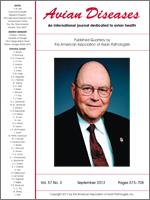There is poor understanding of host responses to avian influenza virus (AIV) infection in wild birds, with most experimental studies using captive-bred birds and highly pathogenic AIVs that have an early endpoint. The objective of this study was to experimentally assess antibody responses and patterns of viral excretion in wild birds challenged with a low pathogenicity AIV. Ruddy turnstones (Arenaria interpres), silver gulls (Chroicocephalus novaehollandiae), and wandering whistling ducks (Dendrocygna arcuata) were challenged with a H6N2 virus, and blood, cloacal, and oropharyngeal (OP) swabs were analyzed from each bird over 28 days, with serology conducted on the ducks for a further 7 mo. Nineteen of 22 birds showed evidence of infection, with respiratory infection prevalent in the turnstones and gulls as mostly low titer viral excretion to 4 days postinoculation (DPI) with gastrointestinal replication detected in only one turnstone. In AIV naive ducks, there was gastrointestinal tropism with moderately high titer viral excretion via the cloaca to 6 DPI and low-grade OP viral excretion to 4 DPI. The hemagglutination inhibition antibody response was poor in the ducks, declining from 19 to 56 DPI, with higher titer responses in the gulls and turnstones. All infected birds responded with elevated nucleoprotein antibodies (in competitive enzyme-linked immunosorbent assay) by 7–10 DPI, and in the ducks these waned slowly after 42 DPI and were long-lived to at least 8 mo. The interspecies variability in response was consistent with a subtype that had adapted well in ducks, while the response of the turnstones may have been influenced by preexisting immunity to AIV. These findings provide insight into AIV infection dynamics in wild birds and highlight the need for further research.
Variación en las respuestas de las especies silvestres de pato, gaviota y aves limícolas a la inoculación con un virus de influenza aviar de baja patogenicidad de origen aviar subtipo H6N2.
Existe poca información sobre las respuestas del huésped a la infección por el virus de la influenza aviar (AIV) en aves silvestres, con la mayoría de estudios experimentales realizados con aves criadas en cautividad y los virus de influenza aviar de alta patogenicidad que tienen un punto final temprano. El objetivo de este estudio fue evaluar experimentalmente las respuestas de anticuerpos y los patrones de excreción viral en las aves silvestres expuestas a un virus de influenza aviar de baja patogenicidad. Vuelvepiedras comunes (Arenaria interpres), gaviotas plateadas (Larus novaehollandiae) y yaguasas errantes (Dendrocygna arcuata) fueron expuestas a un virus H6N2, y muestras de sangre, hisopos cloacales y orofaríngeos se analizaron de cada ave durante 28 días, la serología se llevó a cabo en los patos por siete meses. Diecinueve de 22 aves mostraron evidencia de infección, con infección respiratoria frecuente en los vuelvepiedras y en las gaviotas principalmente con excreción viral con título bajo a los cuatro días después de la inoculación, con replicación gastrointestinal detectada en un vuelvepiedras. En patos no expuestos al virus de la influenza aviar, había tropismo gastrointestinal con una excreción con título moderadamente alto a través de la cloaca a los seis días después de la inoculación y con un grado bajo de excreción viral orofaríngea a los cuatro días después de la infección. La respuesta por anticuerpos inhibidores de la hemaglutinación era pobre en los patos, que declinó de 19 a 56 días después de la inoculación, con respuestas de títulos superiores en las gaviotas y en los vuelvepiedras. Todas las aves infectadas respondieron con anticuerpos elevados contra la nucleoproteína elev





